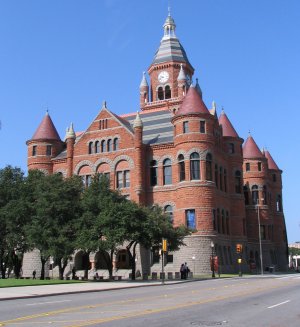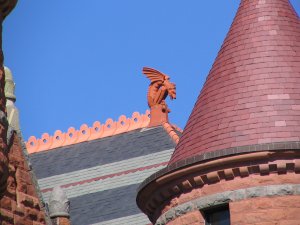Return to Home Page
A Tour of Historic Dealey Plaza
<-Go Back] [Return to Index] [Go Forward->
"Old Red" Dallas County Courthouse
|
Constructed between 1890 and 1893 in the "Victorian Romanesque" style, this eye-catching structure is the sixth county courthouse to stand on the site, which was donated by the city's founder, John Neely Bryan, and his wife Margaret. The first courthouse, a 10-foot square log cabin, was constructed not long after Dallas County was created by an act of the first Texas state legislature on March 30, 1846. After the original cabin burned down in 1848, a second, more substantial version was erected in its place.
The building, adorned with dragon-like "wyverns," was originally surmounted by a huge clock tower. Legend holds that a black man named Burrell Oates, who was convicted of a murder he claimed not to have committed, declared that if he were hanged, the clock would stop - and it did! When workmen were sent aloft to repair the clock, they discovered that the tower was badly cracked. It was removed in 1919 for the sake of public safety. This courthouse, unfortunately, was also the scene of one of the more notorious events in Dallas history. On March 3, 1910 an African-American man, Allen Brooks, was on trial for allegedly assaulting a 3-year old white girl, when a frenzied mob of vigilantes managed to fight their way into the second-floor courtroom where the trial was taking place. After tying a rope around Brooks' neck, they tossed him out the courtroom window. It is uncertain whether or not the fall killed him. Afterward, the mob dragged Brooks down Main Street to a decorative archway that had been erected in 1908 for the Elks convention. There, they hanged the unfortunate Brooks (who was probably already dead by that time) from a nearby telephone pole. You can read about it here in an article in the Fall 2008 issue of Legacies: A History Journal for Dallas and North Central Texas. The courthouse was also the place where in 1919, an Episcopal minister was tried and found guilty of inappropriate behavior involving several girls under his care at the Episcopal orphange in South Dallas. You can read about it here in an article in the Fall 2019 issue of Legacies: A History Journal for Dallas and North Central Texas. |
<-Go Back] [Return to Index] [Go Forward->
This website copyright © 2006-2025 (except where noted) by Steven Butler. All rights reserved.

 This retired Dallas County courthouse, which stands on Houston Street at Dealey Plaza, flanked by Main and Elm streets, is known locally as "Old Red." In 2006, it was refurbished, for use as a museum. In 2007, a clock and bell tower, demolished in 1919 as unsafe, was reconstructed. The "Old Red Museum" operated on the ground floor of the building for thirteen years, from 2007 through 2020, when the courthouse reverted to its original use.
This retired Dallas County courthouse, which stands on Houston Street at Dealey Plaza, flanked by Main and Elm streets, is known locally as "Old Red." In 2006, it was refurbished, for use as a museum. In 2007, a clock and bell tower, demolished in 1919 as unsafe, was reconstructed. The "Old Red Museum" operated on the ground floor of the building for thirteen years, from 2007 through 2020, when the courthouse reverted to its original use. In 1857, a modest, red brick building took the place of the second log cabin courthouse. After becoming structurally unsound, it was torn down and in 1871 a new courthouse, made of gray stone, was constructed on the site. This fourth building lasted only nine years, being destroyed by fire in 1880. Architect James Flanders designed its "Second Empire" style replacement, made of locally quarried limestone at a cost of $100,000. After the supposedly fireproof fifth courthouse burned in 1890, it was replaced by the present structure, which was designed by Maximilian A. Orlopp, Jr. and built at a cost of $350,000.
In 1857, a modest, red brick building took the place of the second log cabin courthouse. After becoming structurally unsound, it was torn down and in 1871 a new courthouse, made of gray stone, was constructed on the site. This fourth building lasted only nine years, being destroyed by fire in 1880. Architect James Flanders designed its "Second Empire" style replacement, made of locally quarried limestone at a cost of $100,000. After the supposedly fireproof fifth courthouse burned in 1890, it was replaced by the present structure, which was designed by Maximilian A. Orlopp, Jr. and built at a cost of $350,000.